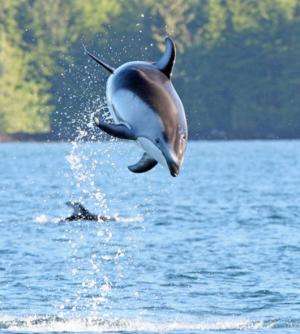Protecting the unprotected

(Phys.org) —Scientists at the University of St Andrews have warned that global efforts to protect marine mammals are likely to leave the most endangered species entirely unprotected.
In a new paper, the researchers say that current methods of habitat protection based on species overlaps in the world's oceans could seriously mislead conservation efforts.
At the United Nations Convention on Biological Diversity in 2012, countries pledged to protect global marine biodiversity by fully protecting 10% of the world's oceans. However, the methods employed to select which areas to protect are more contentious.
Previous research has suggested that range maps of 'presence' and 'absence' could be used to identify and protect species-rich areas, and that protecting just 4% of the world's oceans could ensure the protection of 84% of all marine mammal species.
The new study, led by Dr Rob Williams, set out to examine whether these methods are a reliable way of protecting endangered species. In their report, the researchers show that high species richness is not related to habitat quality or high use areas for each species.
The research was carried out by scientists at the Schools of Biology and Mathematics & Statistics at the University of St Andrews, together with colleagues working in Europe and North America.
Dr Williams, a researcher at the Sea Mammal Research Unit at St Andrews, said, "Unfortunately it seems that we can't rely on current methods. Despite best intentions, it seems that range maps alone are inadequate to inform the tough decisions we need to make about priority areas to protect.
"Sites with the most species never corresponded to the highest-use areas for any individual species. Protecting those species-rich areas would leave the most important habitats for endangered species entirely unprotected.
"There is no substitute for identifying critical habitats of the species most in need of protection, and protecting those. Unfortunately existing methods being used to identify where to put protected areas may not best be serving the species they aim to protect."
The group says that some areas are more useful to animals than others, and all areas of an animal's range cannot be assumed to be equal.
In their paper, published by the journal Ecography, the international team outline practical and cost-effective ways to improve the quality of data available. These could include combining expert opinion-based maps and data from different sources (such as field surveys) with predictive models to identify critical habitats and hotspots.
Professor Steve Buckland, Director of the Centre for Research into Ecological and Environmental Modelling at St Andrews, added, "Too often, lack of adequate data is given as an excuse for taking easy shortcuts, when the real need is to address the minimum data requirement to meet management needs".
Last year, an ambitious target was set at the UN Biodiversity Conference to double resources for biodiversity protection by 2015. High on the agenda is the designation of conservation areas.
The new study's authors say that it is crucial to make methods of protection effective, so that they do most good to the most species, while minimising costs to society.
Dr Sascha Hooker, a Lecturer at the University of St Andrews' School of Biology, explained, "Although it is tempting to think that any habitat protection is better than none, given the scale of conservation problems globally, it is paramount that we make conservation funds work to best maximise conservation gains for the animals concerned – having parks that do little good is a waste of resources".
Study co-author Randall Reeves, Chairman of the IUCN (International Union for the Conservation of Nature) Cetacean Specialist Group, added, "We have already witnessed one human-caused extinction of a dolphin species in our working lifetime, China's Yangtze River dolphin. There is an urgent need for better data and precautionary decision-making to prevent more such tragedies".
The paper 'Prioritizing global marine mammal habitats using density maps in place of range maps' is published by Ecography online at: onlinelibrary.wiley.com/doi/10 … 013.00479.x/abstract
Journal information: Ecography
Provided by University of St Andrews



















